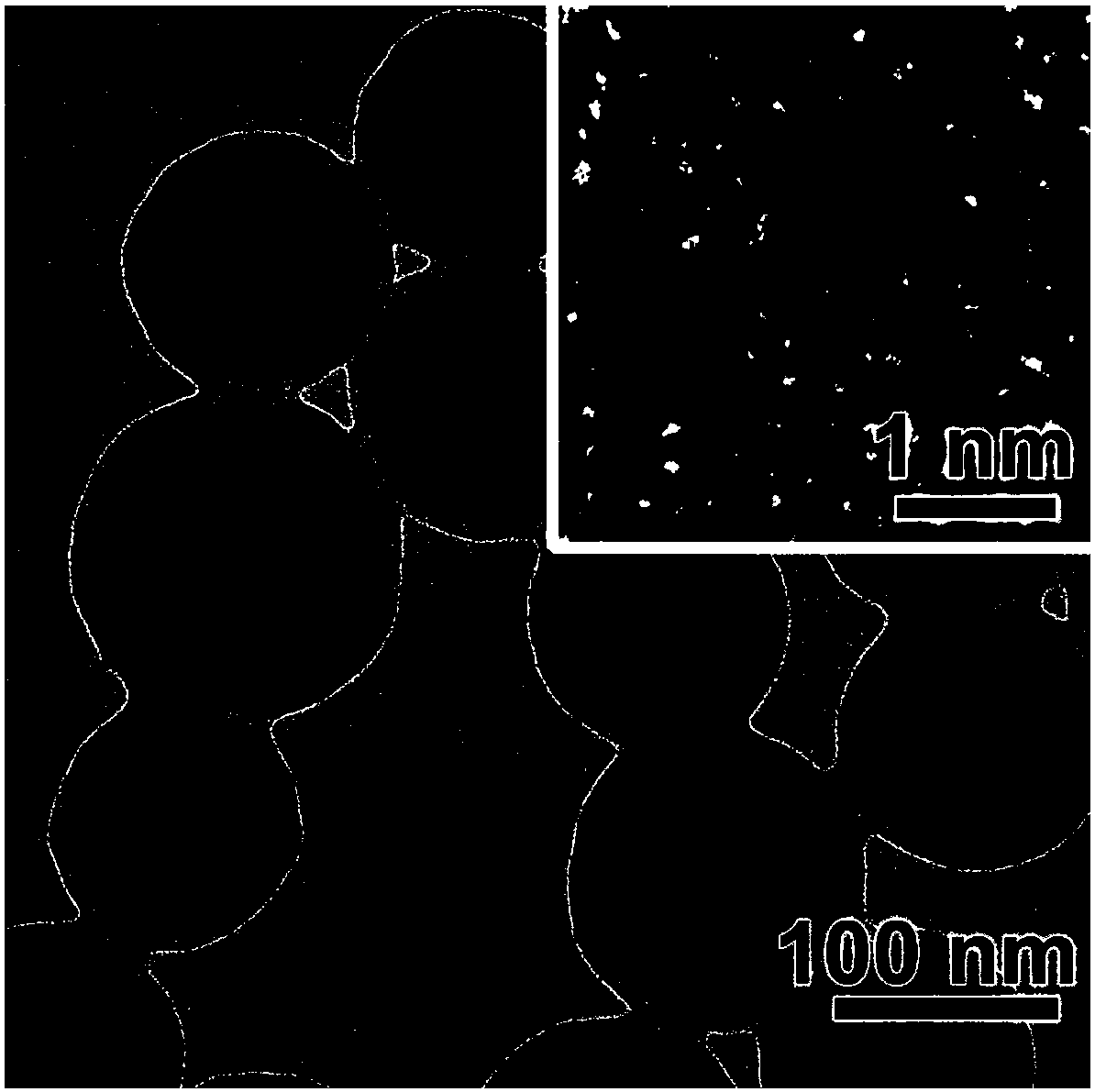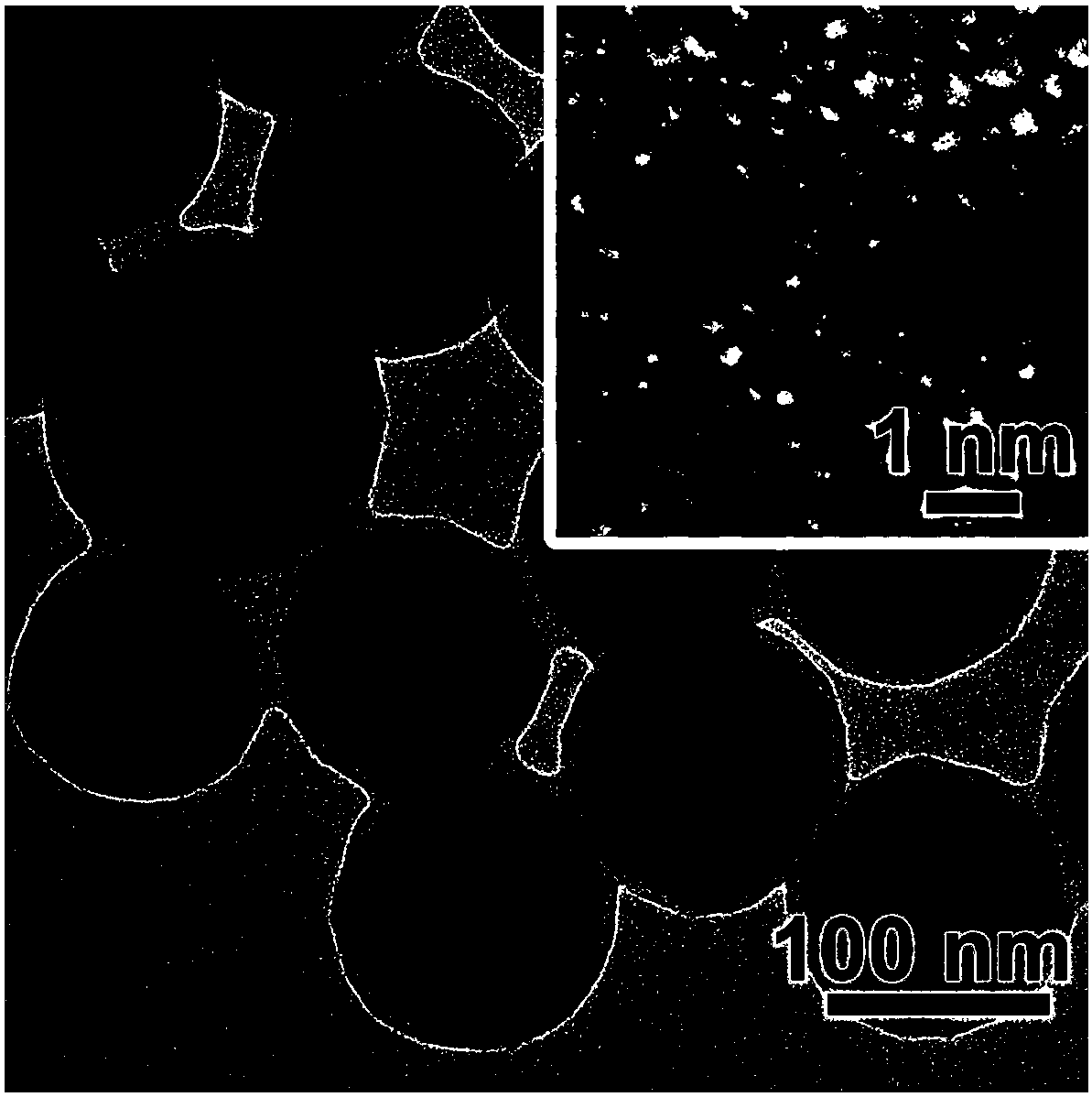A kind of preparation method of organic hydrogenation reaction catalyst based on noble metal nanoparticles
A nanoparticle and hydrogenation reaction technology, applied in the field of nanomaterials, can solve the problems of complex catalyst preparation method and unoptimized catalytic activity, and achieve the effect of excellent catalytic activity
- Summary
- Abstract
- Description
- Claims
- Application Information
AI Technical Summary
Problems solved by technology
Method used
Image
Examples
Embodiment 1
[0039] 1) Preparation of ~100nm silica spheres: Add 15mL tetraethyl orthosilicate (TEOS) into a mixed solution consisting of 294mL ethanol, 24mL deionized water and 7.5mL ammonia solution (28wt%), and stir at room temperature for 12 hours. The silica spheres were centrifuged and redispersed into 50 mL of isopropanol (HPLC grade), then added 0.1 mL of 3-amino-4-hydroxybenzenesulfonic acid (APS), refluxed at 70 °C for 10 hours, then centrifuged, and the solid part was used Wash with a mixture of absolute ethanol and water, and redisperse in 150 ml of absolute ethanol to obtain an amino-modified substrate dispersion.
[0040] 2) Prepare an ultra-small platinum nanoparticle film layer on the surface of the silicon sphere. Take 3mL of the amino-modified substrate dispersion prepared in step 1), add it to a mixture of 20mL absolute ethanol, 125mL deionized water and 0.2mL ammonia solution (28wt%), add 0.3g dodecyl Sodium benzenesulfonate (SDBS), stirred evenly to obtain the base mi...
Embodiment 2
[0043] 1) Preparation of ~100nm silica spheres: Add 15mL tetraethyl orthosilicate (TEOS) into a mixed solution consisting of 294mL ethanol, 24mL deionized water and 7.5mL ammonia solution (28wt%), and stir at room temperature for 12 hours. The silica spheres were centrifuged and redispersed into 50 mL of isopropanol (HPLC grade), then added 0.1 mL of 3-amino-4-hydroxybenzenesulfonic acid (APS), refluxed at 70 °C for 10 hours, then centrifuged, and the solid part was used Wash with a mixture of absolute ethanol and water, and redisperse in 150 ml of absolute ethanol to obtain an amino-modified substrate dispersion.
[0044] 2) Prepare an ultra-small platinum nanoparticle film layer on the surface of the silicon sphere. Take 3mL of the amino-modified substrate dispersion prepared in step 1), add it to a mixture of 20mL absolute ethanol, 125mL deionized water and 0.2mL ammonia solution (28wt%), add 0.3g dodecyl Sodium benzenesulfonate (SDBS), stirred evenly to obtain the base mi...
Embodiment 3
[0047] 1) Preparation of ~100nm silica spheres: Add 15mL tetraethyl orthosilicate (TEOS) into a mixed solution consisting of 294mL ethanol, 24mL deionized water and 7.5mL ammonia solution (28wt%), and stir at room temperature for 12 hours. The silica spheres were centrifuged and redispersed into 50 mL of isopropanol (HPLC grade), then added 0.1 mL of 3-amino-4-hydroxybenzenesulfonic acid (APS), refluxed at 70 °C for 10 hours, then centrifuged, and the solid part was used Wash with a mixture of absolute ethanol and water, and redisperse in 150 ml of absolute ethanol to obtain an amino-modified substrate dispersion.
[0048] 2) Prepare an ultra-small platinum nanoparticle film layer on the surface of the silicon sphere. Take 3mL of the amino-modified substrate dispersion prepared in step 1), add it to a mixture of 20mL absolute ethanol, 125mL deionized water and 0.2mL ammonia solution (28wt%), add 0.3g dodecyl Sodium benzenesulfonate (SDBS), stirred evenly to obtain the base mi...
PUM
| Property | Measurement | Unit |
|---|---|---|
| particle diameter | aaaaa | aaaaa |
| particle size | aaaaa | aaaaa |
| particle size | aaaaa | aaaaa |
Abstract
Description
Claims
Application Information
 Login to View More
Login to View More - R&D
- Intellectual Property
- Life Sciences
- Materials
- Tech Scout
- Unparalleled Data Quality
- Higher Quality Content
- 60% Fewer Hallucinations
Browse by: Latest US Patents, China's latest patents, Technical Efficacy Thesaurus, Application Domain, Technology Topic, Popular Technical Reports.
© 2025 PatSnap. All rights reserved.Legal|Privacy policy|Modern Slavery Act Transparency Statement|Sitemap|About US| Contact US: help@patsnap.com



